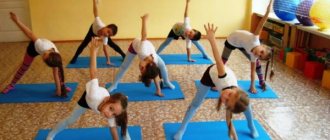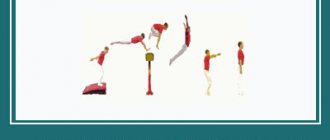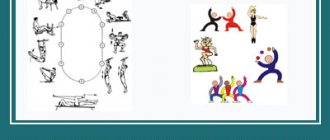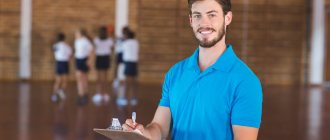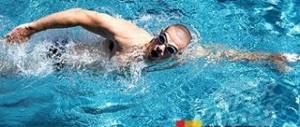In accordance with the federal state educational standard of general primary education, approved by order of the Ministry of Education and Science of the Russian Federation dated October 6, 2009 No. 373, it corresponds to the basic curriculum of the MBOU "Secondary School", adopted on August 29, 2014, according to which the study of physical education in 1st grade is allocated 99 hours (3 hours per week). The third hour of teaching the subject “Physical Culture” was introduced by order of the Ministry of Education and Science dated August 30, 2010 No. 889. The order stated: “The third hour of the subject “Physical Culture” should be used to increase motor activity and develop the physical qualities of students, introduce modern systems of physical education".
Subject, purpose, objectives of physical culture
The academic subject “Physical Education” is included in the educational area “Physical Education”.
The subject of physical education in 1st grade: promoting health, improving physical qualities, mastering certain motor actions, developing thinking, creativity and independence.
The goal of school physical education : the formation of a well-rounded physically developed personality, capable of actively using the values of physical education to strengthen and long-term preserve one’s health, optimize work activity and organize active recreation.
Fulfilling this goal is associated with solving the following educational tasks :
- promoting health, improving posture, preventing flat feet, promoting harmonious physical, moral and social development, successful learning;
- formation of initial self-regulation skills through physical education;
- mastering the school of movements;
- development of coordination (accuracy of reproduction and differentiation of spatial, temporal and power parameters of movements, balance, rhythm, speed and accuracy of response to signals, coordination of movements, orientation in space) and conditioning (speed, speed-strength, endurance and flexibility) abilities;
- formation of basic knowledge about personal hygiene, daily routine, the effect of physical exercise on health, performance and the development of physical (coordination and conditioning) abilities;
- developing ideas about the main sports, equipment and equipment, and compliance with safety rules during classes;
- formation of an attitude towards maintaining and strengthening health, healthy and safe lifestyle skills;
- introduction to independent physical exercises, outdoor games, using them in free time based on the formation of interests in certain types of physical activity and identifying a predisposition to certain sports;
- instilling discipline, a friendly attitude towards comrades, honesty, responsiveness, courage during physical exercises, promoting the development of mental processes (idea, memory, thinking, etc.) during motor activity.
Taking into account the above-mentioned objectives of educating primary school students in the field of physical education, the main principles, ideas and approaches in the formation of this program were the following:
- democratization and humanization of the pedagogical process,
- pedagogy of cooperation,
- activity approach,
- intensification and optimization,
- expansion of interdisciplinary connections.
The principle of democratization in the pedagogical process is expressed in providing each and every student with equal access to the basics of physical education, maximizing the development of children’s abilities, building teaching based on the use of broad and flexible methods and means of teaching for the development of children with different levels of their motor and mental abilities, changing the essence pedagogical relations, the transition from subordination to cooperation.
The principle of humanizing the pedagogical process is to take into account the individual abilities of each child and teacher. It is built in accordance with the personal experience and level of achievement of schoolchildren, their interests and inclinations. Teachers are required to provide children with program material of different levels in complexity and subjective difficulty of mastering.
The implementation of the principles of democratization and humanization in the pedagogical process is possible on the basis of cooperation pedagogy - the idea of joint developmental activities of children and adults, during which they are connected by mutual understanding and penetration into each other’s spiritual world, by a joint desire to analyze the progress and results of this activity.
The activity-based approach is to focus the student not only on mastering ready-made knowledge and skills, but also on mastering the methods of physical education, health and sports activities, and on developing the child’s cognitive powers and creative potential. This is a departure from verbal methods and forms of transferring ready-made information, passivity, students in the classroom to the active acquisition of knowledge, skills and abilities, implemented in various types of physical education and sports activities.
Intensification and optimization consists of:
- increasing the focus of learning and strengthening motivation for physical education and sports;
- application of active and creative methods and forms of teaching: problem-based,
- research,
- associated development of conditioning and coordination abilities,
- accentuated and comprehensive development of coordination abilities,
- software-algorithmic methods,
- group and individual forms of training,
- circuit training, etc.;
The teacher implements the task of forming a holistic worldview of students, comprehensively revealing the relationship and interdependence of the studied phenomena and processes in the field of physical education on the basis of expanding interdisciplinary connections from the field of different subjects: literature, history, mathematics, anatomy, physiology, psychology, etc.
The goal of the 3rd physical education lesson is to create conditions for the implementation of physical education and health activities of students, regardless of the level of physical fitness and the level of development of specific skills in individual sports. Therefore, the content of the 3rd lesson of physical education is aimed not only at the implementation of generally accepted sections (athletics, gymnastics, ski training, etc.), but also at the introduction of such variable sections as choreography, rhythm, fitness, sports and ballroom dancing, national sports sports, national sports games and team relay games.
This work program provides material for replacing ski training lessons with outdoor games and gymnastics lessons (30 hours for grades 2-4) - Appendix 1. This material will be used when climate conditions change (increase in temperature and the resulting melting of snow in January - March).
Methodology for conducting a physical education lesson in elementary school according to the Federal State Educational Standard
Conducting physical education lessons in primary school is not so much educational as it is health-improving in nature, and also provides an opportunity for primary schoolchildren to take a break from a new regime of classes for them - more strict than in a preschool educational organization [3].
This necessitates a slightly different approach to organizing physical education lessons in primary schools. First of all, this is the organization of such lessons in a playful way, using a large number of different gaming methods and techniques. It is also important for primary schoolchildren when organizing physical education lessons to create conditions for a constant change of activities [4].
These fundamentals of organizing physical education lessons in primary school are reflected in the requirements of the federal state educational standard for primary general education (FSES NOO) [1].
In particular, the Federal State Educational Standard of NEO stipulates that in physical education lessons, students must master the skills of organizing their sports activities, working in a team to achieve a common goal (which is facilitated by various team games and relay races), the ability to set goals and implement them [2].
An important skill, according to the Federal State Educational Standard for Educational Education, which must be acquired by primary school students during physical education lessons, is the ability to assess the permissible level of physical activity (based on heart rate) [1].
It is advisable to develop such skills when younger schoolchildren study theoretical material - for example, using a textbook. At the same time, the theoretical study of such issues should be accompanied by subsequent practical application of the studied material (for example, you can ask students to measure their heart rate several times during the lesson, record the results and analyze them, for example, build a graph). This approach will contribute not only to the formation of subject-specific, but also meta-subject educational results, which is quite important when teaching in primary school in general, as well as in the context of the Federal State Educational Standard of Education.
A key element of the methodology for teaching physical education is to provide students, in some cases, with a choice for organizing certain parts of the lesson [2]. For example, it is advisable for students to be asked to choose a game, a lesson format, and a location (for example, by offering to conduct the lesson outside - under appropriate weather conditions). This approach to the methodology of conducting a physical education lesson for primary school students is also quite relevant in the context of the Federal State Educational Standard of Education, as it allows us to consider students as full-fledged subjects of the educational process, to teach them the possibilities and criteria for choosing and independently organizing their educational and sports activities.
It is also important in the context of the Federal State Educational Standard for Educational Education to teach children how to set a lesson goal (which students must formulate independently, together with the teacher), planning to achieve the goal, as well as assessing its achievement (results) at the end of the lesson [1].
It is also important to organize educational activities during the lesson in the form of a sequential series of educational tasks, while each task must be disclosed to students, as well as evaluated after its implementation.
It is advisable to offer students (taking into account age characteristics) and choose methods and ways of solving an educational task, which also allows additional training in goal setting [3].
Thus, the methodology for conducting a physical education lesson according to the Federal State Educational Standard of Educational Education involves providing students with greater freedom in setting their educational goals, planning and choosing ways to achieve them, as well as learning effective communication in this process.
Bibliography
- On the approval and implementation of the federal state standard for primary general education: order of the Ministry of Education and Science of Russia dated October 6, 2009 N 373 (as amended on December 18, 2012) // Bulletin of normative acts of federal executive authorities. - N 12. - 03/22/2010; Russian newspaper. — 2011. — February 16. - N 5408.
- Zolotova, M. Yu. Fun gymnastics for younger schoolchildren / M. Yu. Zolotova, T. Yu. Maskaeva // Physical culture at school. 2020. N 1. P. 40-43.
- Matveev, A.V. Physical education: 1st grade. : methodological recommendations on the basics of teaching / A. P. Matveev, M. V. Malykhina. M.: Bustard, 2013. 208 p.
- Mironov, A.V. How to structure a lesson in accordance with the Federal State Educational Standard / A.V. Mironov. – Volgograd: Teacher, 2013. – 174 p.
Program content
The content of the lesson program material consists of two main parts: basic and variable (differentiated).
Mastering the basic principles of physical education is necessary for every student.
The basic component forms the basis of the State Standard of General Educational Training in the field of physical education. The variable part of physical education is associated with taking into account the individual abilities of students and the local characteristics of the school.
The program consists of interconnected parts: physical education lessons, physical education and health activities in academic, extracurricular, extended day modes; extracurricular activities and physical education events.
Basic part
- Natural knowledge bases:
- Health and physical development of the child.
- Basic forms of movements.
- Respiratory function.
- Performing basic movements with objects, at different speeds, on a limited area of support.
- Measurement of height, weight, position in space.
- Social and psychological foundations:
- The influence of physical exercise, hardening procedures, personal hygiene and daily routine on health promotion.
- Performing vital skills and abilities (walking, running, jumping, throwing, climbing, climbing) in a play environment.
- Monitoring the performance of physical exercises and testing physical qualities.
- Hardening techniques:
- air baths,
- sunbathing,
- water procedures.
In the program for mastering educational material, theoretical sections are combined with practical ones, the basis of which is a physical education lesson, divided into 3 types: with an educational-cognitive, educational-subject and educational-training orientation.
Sports and recreational activities
- Gymnastics with elements of acrobatics:
- formation, combat actions in a line, column;
- execution of drill commands;
- exercises in climbing and climbing, in balance;
- exercises as instructed by the teacher.
- Athletics:
- running with high hip lifts;
- running at a slow pace;
- changing running pace;
- breathing while running;
- running and walking technique;
- jumps on one, two legs, long and high;
- jumping and jumping;
- passing and catching a small ball;
- throwing at a vertical target and at a distance;
- throwing a large ball (1 kg) at a distance in different ways.
- Outdoor and sports games. The variety of motor actions has a complex effect on improving coordination and conditioning abilities, as a result of which the foundations of gaming activity are laid, improving movements (walking, running, jumping, throwing).
- General developmental exercises for basic types and within sections.
In the process of mastering educational activities in physical education classes, health is strengthened, physical qualities are improved, thinking, creativity and independence are actively developed.
Results of mastering the subject “Physical Education”
In accordance with the requirements for the results of mastering the basic educational program of primary general education of the Federal State Educational Standard (Order of the Ministry of Education and Science of the Russian Federation dated October 6, 2009 No. 373), this work program for grades 1–4 is aimed at achieving personal, meta-subject and subject results in physical culture.
Personal results
- developing a sense of pride in one’s Motherland, the Russian people and the history of Russia, awareness of one’s ethnicity and nationality;
- developing a respectful attitude towards the culture of other peoples;
- development of motives for educational activities and the personal meaning of learning, acceptance and mastery of the social role of the teacher;
- development of ethical feelings, goodwill and emotional and moral responsiveness, understanding and empathy for the feelings of other people;
- developing skills of cooperation with peers and adults in different social situations, the ability not to create conflicts and find ways out of controversial situations;
- development of independence and personal responsibility for one’s actions based on ideas about moral standards, social justice and freedom;
- formation of aesthetic needs, values and feelings;
- formation of an attitude towards a safe, healthy lifestyle.
Meta-subject results
- mastering the ability to accept and maintain the goals and objectives of educational activities, searching for means of its implementation;
- developing the ability to plan, control and evaluate educational activities in accordance with the task and the conditions for its implementation; determine the most effective ways to achieve results;
- defining a common goal and ways to achieve it; the ability to negotiate the distribution of functions and roles in joint activities; exercise mutual control in joint activities, adequately assess one’s own behavior and the behavior of others;
- willingness to constructively resolve conflicts by taking into account the interests of the parties and cooperation;
- mastering basic information about the essence and characteristics of objects, processes and phenomena of reality in accordance with the content of a specific educational subject;
- mastery of basic subject and interdisciplinary concepts that reflect essential connections and relationships between objects and processes.
Subject results
- formation of initial ideas about the importance of physical culture for strengthening human health (physical, social and mental), about its positive impact on human development (physical, intellectual, emotional, social), about physical culture and health as factors of successful study and socialization;
- mastering the skills to organize health-saving activities (daily routine, morning exercises, recreational activities, outdoor games, etc.);
- developing the skill of systematically monitoring one’s physical condition, the amount of physical activity, health monitoring data (height, body weight, etc.), indicators of the development of basic physical qualities (strength, speed, endurance, coordination, flexibility).
Planned results
| Planned results | Teacher's comment | ||
| Subject | Metasubject UUD | Personal UUD | |
| 9 | 10 | 11 | 12 |
| Know what organizational and methodological requirements are used in physical education lessons, how to perform drill exercises, the rules of the outdoor games “Trap” and “Sorcerers” | Communication skills: listen and hear each other, work in a group. Regulatory: determine a new level of attitude towards oneself as a subject of activity, find and highlight the necessary information. Cognitive: talk about the organizational and methodological requirements used in physical education lessons, perform drill exercises, play outdoor games “Trap” and “Sorcerers” | Development of motives for learning activities and awareness of the personal meaning of learning, acceptance and development of the social role of the student, development of skills of cooperation with peers and adults in different social situations | |
| Know how to test the 30 m run from a high start, the rules of the outdoor games “Salki” and “Salki - give me your hand” | Communicative: express your thoughts with sufficient completeness and accuracy in accordance with the tasks and conditions of communication, establish working relationships. Regulatory: independently formulate cognitive goals, find and highlight the necessary information. Cognitive: take a 30 m run test from a high start, play outdoor games “Tag” and “Tag - give me your hand” | Development of ethical feelings, goodwill and emotional-moral responsiveness, independence and personal responsibility for one’s actions based on ideas about moral standards, social justice and freedom | |
| Know the technique of shuttle running, the rules of the outdoor games “Interrupted Tag” and “Sorcerers” | Communication: collaborate effectively and promote productive cooperation, work in a group. Regulatory: see a mistake and correct it as directed by an adult, maintain a given goal. Cognitive: technically perform shuttle running, play outdoor games “Interrupted Tag” and “Sorcerers” | Development of motives for educational activities and awareness of the personal meaning of learning, development of ethical feelings, goodwill and emotional and moral responsiveness, independence and personal responsibility for one’s actions based on ideas about moral standards, social justice and freedom | |
| Know how the 3 x 10 m shuttle run is tested, the rules of the outdoor game “Doggies with kicks” | Communicative: collaborate effectively and promote productive cooperation, obtain missing information through questions. Regulatory: determine a new level of attitude towards oneself as a subject of activity, adequately understand the assessment of an adult and a peer. Cognitive: take the 3 x 10 m shuttle run test, play the outdoor game “Kick Dogs” | Development of motives for educational activities and awareness of the personal meaning of learning, acceptance and mastery of the social role of the student, development of ethical feelings, goodwill and emotional and moral responsiveness | |
Requirements for the level of student preparation by the end of the 1st year of study
As a result of mastering the program material, the student will gain knowledge:
Knowledge about physical culture
- What is coordination of movements.
- What is distance?
- How did physical culture and sports arise?
- Students will receive initial information about the Olympic Games - when they appeared, who recreated the symbols and traditions.
- What is physical culture.
- They will get an idea of what tempo and rhythm are, why they are needed and how they affect the performance of exercises.
- What is personal hygiene?
- They will receive initial information about the internal organs of a person and his skeleton.
- They will find out what gymnastics is, where it appeared and why it was named so.
- What is posture?
Gymnastics with elements of acrobatics
- Students will learn to form lines and columns;
- open your arms to the sides;
- reform in two columns;
- make turns to the right, left, around;
- commands “match up”, “at attention”, “calculate in order”, “calculate for the first or second”, “left in a roundabout step march”, “step march”, “run march”;
- perform a warm-up aimed at developing coordination of movements;
- remember short periods of time;
- pull up on a low bar from a hanging position;
- hang for a while;
- go through circuit training stations;
- perform various rolls, forward somersaults, bridges, shoulder stands, headstands;
- climb and climb over the gymnastic wall;
- rope climbing;
- perform hangs on the crossbar;
- jumping rope, jumping rope, hoop spinning;
- hanging at an angle, hanging bent over, hanging over and turning over on gymnastic rings.
Athletics
- Students will learn the high start technique;
- run a distance of 30 m at speed;
- perform shuttle run 3 x 10 m;
- running warm-up;
- throwing for both distance and accuracy;
- standing long jump technique;
- perform a high jump from a straight run, as well as a high jump backwards;
- run various relay races;
- perform medicine ball throws from the chest and from below.
Ski training
- Students will learn to carry skis on command “on the shoulder”, “under hand”;
- perform stepping and sliding steps both with and without poles, turns by stepping both with and without poles, climbing the slope in a “half herringbone” with and without ski poles, descending downhill in the main stance with and without ski poles;
- fall braking;
- walk a distance of 1.5 km;
- Snake skiing.
Outdoor games
- Students will learn to play outdoor games: “Trap”,
- "Trap with a bag on his head"
- "Interrupted Tags"
- "Swan geese",
- "Burners"
- "Wizards"
- "Mousetrap",
- "Salki"
- "Tags with houses"
- "Two Frosts"
- "Wolf in the Moat"
- "The Hunter and the Hares"
- "Who will grab it faster"
- "Owl-ka"
- "Siege of the City"
- "Dodgeballs"
- "Night Hunt"
- "Fishing rod",
- "Hurry up to clean it up"
- "Magic Christmas trees"
- "Bumblebee",
- "Take care of the object"
- "Jumping Sparrows"
- "Squirrels in the Forest"
- "Protector Squirrel"
- "Runners and Jumpers"
- "Naughty mushrooms"
- "Boiler",
- "Hunters and Ducks"
- "Anti-bouncers"
- "Throw balls at your opponent"
- "Bouncers over the net"
- "Right on target"
- "Doggies"
- "Forest, swamp, lake"
- "Prohibited movement"
- "Tails"
- "Tails"
- "Throw far, collect faster"
- "Bird Game"
- "Birds game with ball"
- "Day and night";
The academic subject “Physical Education” is closely interconnected with all subjects of the school course. Almost all subjects of Physical Education are based on the knowledge acquired by students while studying other general education subjects.
Therefore, interdisciplinary communication is certainly used in Physical Education lessons:
- Lifestyle - healthy lifestyle, first aid, frostbite, burns;
- geography - tourism, survival in nature;
- chemistry - respiration processes;
- physics - natural phenomena, acceleration, distance, mass, power, force;
- history - the history of the Olympic Games, the history of sports;
- mathematics - distance, speed;
- biology - schoolchildren’s daily routine, diet, provision of primary care, muscle work, blood circulation, fatigue, environmental safety;
